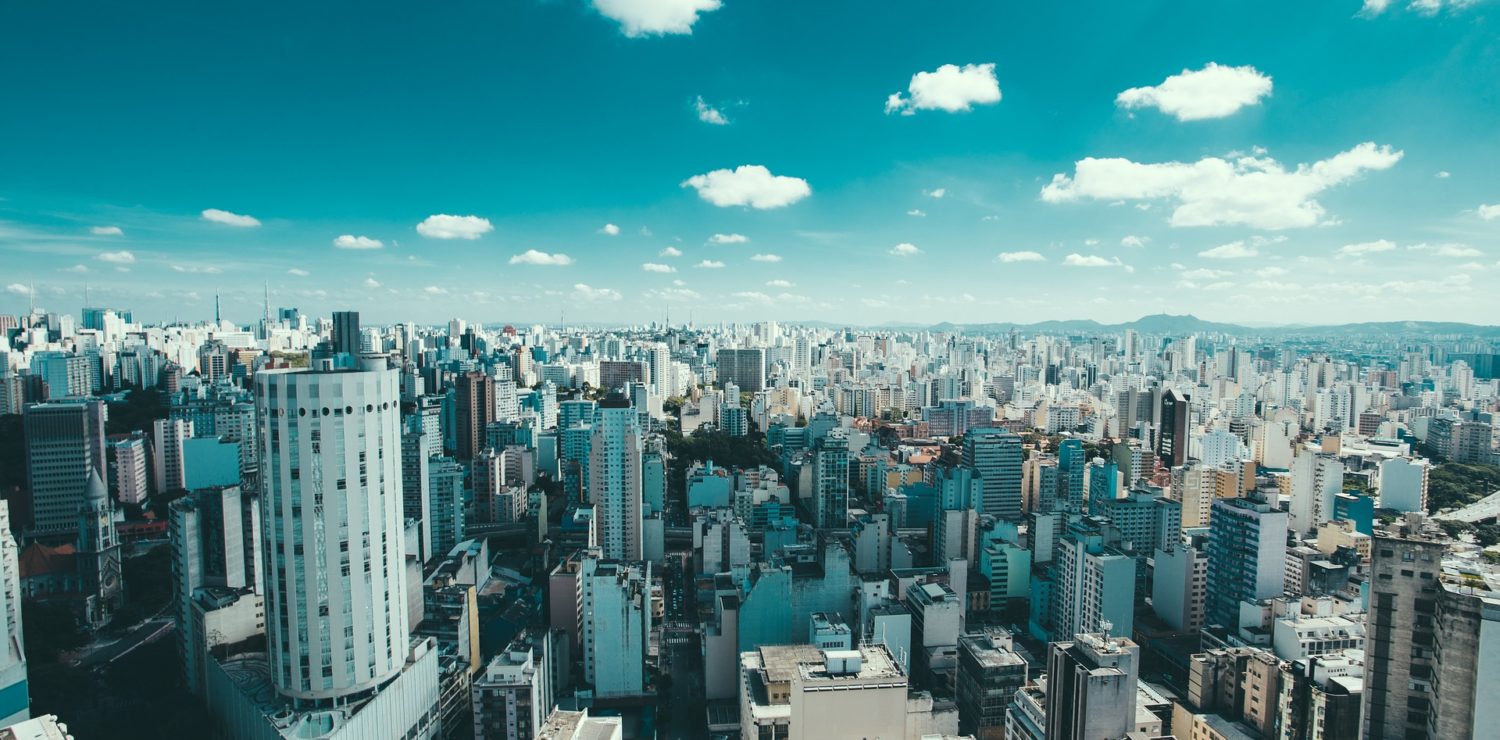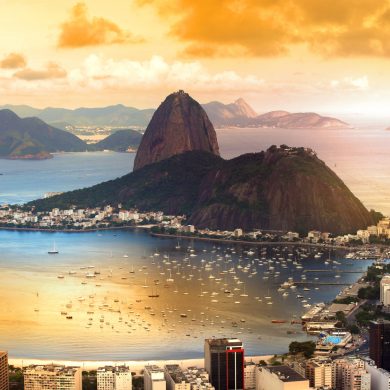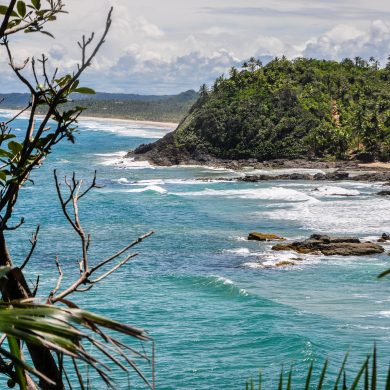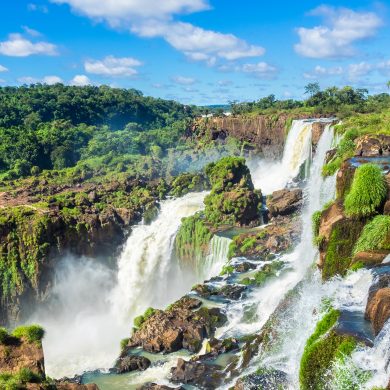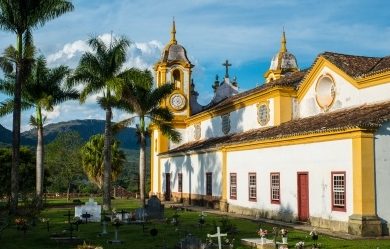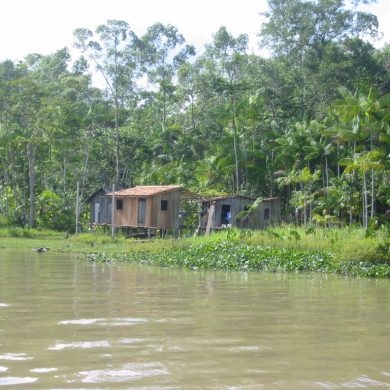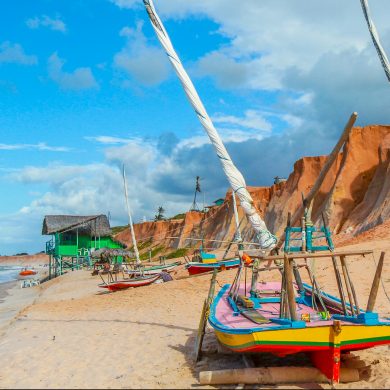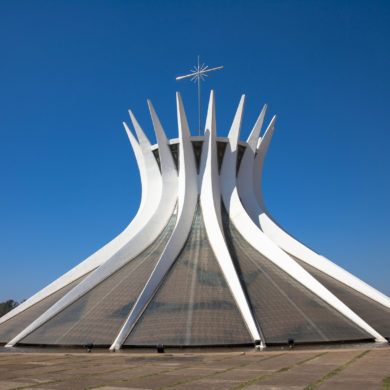São Paulo, the huge megalopolis that never stops, is the economic capital of Brazil but also has a rich cultural background.
Home to the largest airport in the country, it is a virtually a mandatory destination for travelers on a long trip in Brazil.
When one thinks of a trip to Brazil, most often two postcard places dominate, the mysterious Amazon jungle and the relaxed city of Rio de Janeiro. Yet, if the latter is a city of unique beauty, its eternal rival São Paulo has nothing to envy in terms of diversity and cultural vitality. “S.P” offers another vision; a Brazil firmly anchored in modernity, far from the more traditional lives of the countryside.
This popular Brazil vacation package allows you to discover the largest city in Latin America and its 12 million inhabitants, presents the opportunity to get to know new aspects of Brazil. With its buildings as far as the eye can see, helicopters roaring in the sky and its financial center, São Paulo is the dominant economic power of the South American continent. It reveals a decidedly urban way of life, echoing the great European cities that many of the ancestors of its inhabitants come from.
In this buzzing metropolis, travelers enjoy an important cultural liveliness. Many museums such as the famous MASP (São Paulo Museum of Art) are worth visiting. A stay in São Paulo is also an opportunity to enjoy a rich architectural heritage and witness the prosperity of the city. It has been growing and developing since its founding in 1554 by Jesuit pioneers of the Portuguese-speaking colonization.
Lovers of urban and nightlife will have countless opportunities for outings. Whether to stroll in the famous Ibirapuera Park or go shopping on the famous Avenida Paulista, relax with a drink in an international bar, enjoy a gourmet meal or listen to the full range of local and international music, one can never get bored in São Paulo!
On your São Paulo vacation
discover :
Avenida Paulista
Metropolitan Cathedral
Ibiruapuera park
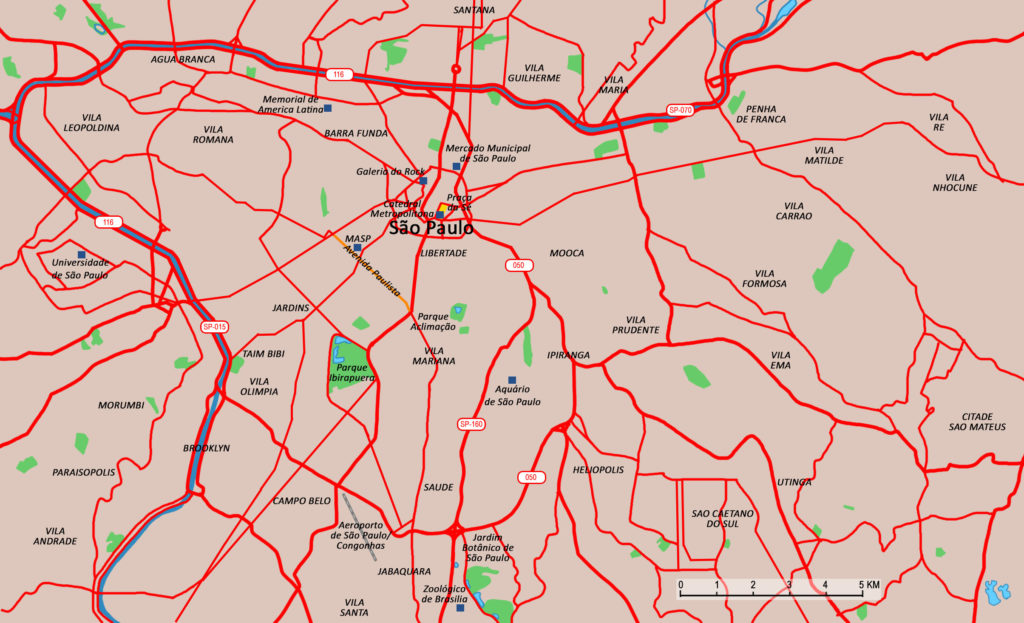
The stay in São Paulo includes :
•1 private transfer from one of São Paulo’s airports to the hotel
•1 night in a double room at the hotel (to be chosen in the accommodation section at the bottom of the page)
•1 private transfer between the hotel and one of São Paulo’s airports
São Paulo, a rich history from the bandirantes to the financiers
The city of São Paulo takes its name from the founding date of the “Pátio do Colégio” college, on January 25, day of the conversion of Saint Paul, chosen by Father José de Anchieta. It is from this building that the small town became the third largest city in the world.
With 12 million inhabitants on 1500 km2, São Paulo is today the figurehead of the Brazilian economy and has the largest GDP south of the equator. However, isolated from the coast by mountains, it has not always been so. Its economy had been relatively stagnant for a long time because of a lack of easy access to the rest of the Portuguese colony scattered along the coast of the Atlantic Ocean.
It was, from the start however, a strategic base for the expansion of Portuguese settlers into the interior of Brazil through the expeditions of the famous “Bandeirantes.” Mostly a mix of Portuguese and natives, these reckless adventurers, organized into small armies of several hundred men, are now part of the local folklore although their image has been softened, becoming one of brave pioneers exploring the vast expanses of Brazil.
In fact, from the sixteenth century, they travelled around São Paulo and the surrounding areas capturing Indians to sell as slaves and looking for precious metals. At the same time, these pioneers opened vast territories for colonization going north beyond Minas Gerais to the marshes of the Pantanal in the south. This was beyond the limits of the Treaty of Tordesillias, which shared the South between Portuguese and Spanish. The legends around these fierce warriors are numerous and they are credited with the discovery of many deposits of gold and diamonds, but also the capture and death of tens of thousands of Indians, like many Jesuit and Quilombola communities. They are in any case representatives of the “Conquest of the West” in Brazil.
Mineral reserves became quickly exhausted however, and in the eighteenth century, it was to the cane and its precious sugar that the “Paulistanos” then turned, to send it to Europe through the “Calçada do Lorena,” the first road to the coast and the port of Santos. A century later, it was the “black gold,” coffee that gave an economic lift to the city thanks to the possibility of large-scale export via the first railway line to Santos built by the English.
With its development, the region of São Paulo became very attractive for new waves of settlers from around the world, mainly Italian but also Spanish, Lebanese, Syrian and even Japanese, which now represents the largest group of immigrants. Today we find their influences in the local cuisine, São Paulo serves 1 million pizzas a day! An interesting cultural cosmopolitanism to discover when visiting the city.
In this ever – growing city, the population doubled between 1880 and 1895 and reached its first million inhabitants before the 1930s, 6 million in 1970 and 10 million in 2000. At the same time the city was modernizing and beginning to become an important industrial center in direct competition with Belo Horizonte further north, and Rio, the then capital of Brazil. This economic, political and cultural rivalry would never stop and would be one of the reasons for the construction of Brasilia.
In the second half of the twentieth century, the development of other industries in the rest of the country pushed the city to turn more towards the tertiary sector and big companies began to settle along the famous 2.7 kilometers of Avenida Paulista, which became the true financial heart of Brazil, supplanting Rio de Janeiro. On this occasion, the former homes of the “Barons do café” that bordered it, would be demolished and replaced by skyscrapers. Some however, have been preserved and classified as heritage sites and travelers see them during their tours of São Paulo.
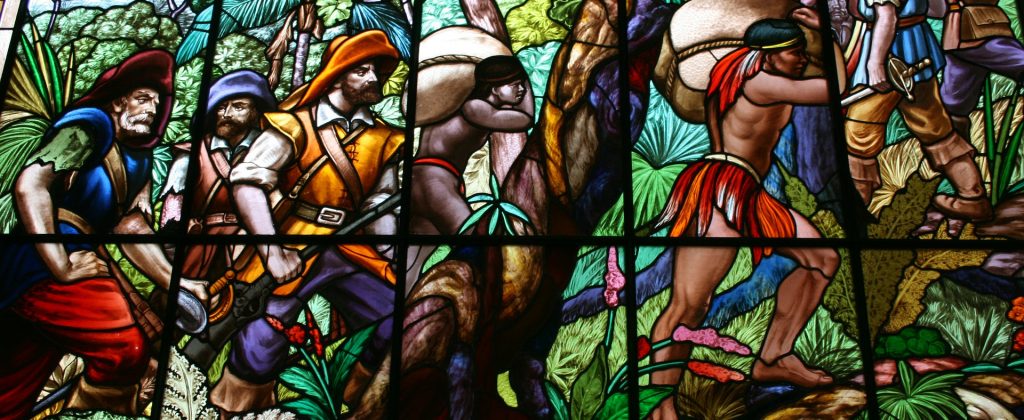
São Paulo, a Latin megalopolis and the economic heart of Brazil
The Amazon offers nature with extraordinary gigantism, São Paulo is its urban counterpart.
São Paulo is a huge city, so big that it is practically impossible to live on one side and work on the opposite, or you will spend most of your day in the legendary traffic jams or the maze of public transport. It is hard to imagine such a metropolis, even seen from aircraft during the landing, it seems to extend to infinity. With its peripheral cities, São Paulo represents no less than 21 million inhabitants, and has 2 airports, Congonhas in the city, only for domestic flights and Guarulhos 25km from the center taking charge of international flights. An important detail when planning a stopover.
A city of disproportion in many ways, the largest megalopolis of the southern hemisphere is a city of extremes, where the historical heritage of European charm rubs shoulders with the ostentatious modernity of the glass towers on Avenida Paulista. There are luxury residences inhabited by an economic elite with extravagant tastes sometimes concentrated in upscale neighborhoods such as the “Gardens” of Pinheiros area, but also side by side with the immense favelas that surround the city. These were more than 600 in number at the last census, places such as Paraisópolis house as many as 100,000 inhabitants.
It is also the city with the largest helicopter fleet in the world. Brazil’s first hub with 30% of flights in the country, its air traffic is particularly intense and the air bridge between São Paulo and Rio de Janeiro is the densest in the world with 214 flights on average per day between the two cities.
On the financial side, the GDP of São Paulo in 2018 totaled US$ 11,602 per capita. The city houses the national headquarters of 63 international groups, 17 of the 20 largest banks and B3, the stock exchange of Brazil, which has a wealth of 13 billion dollars. It is also one of the 10 most expensive cities in the world.
With São Paulo, we are far from the image of an essentially rural and underdeveloped Brazil. For travelers, a trip to São Paulo and the discovery of the life of the paulistas makes it possible to grasp the paradox of an urban Brazil at the cutting edge of technology. However, the expansion crusades of this modern-day population takes place on the home of a very traditional people, as with all vast spaces in Brazil, they were originally populated with indigenous tribes living by immutable life styles for millennia.
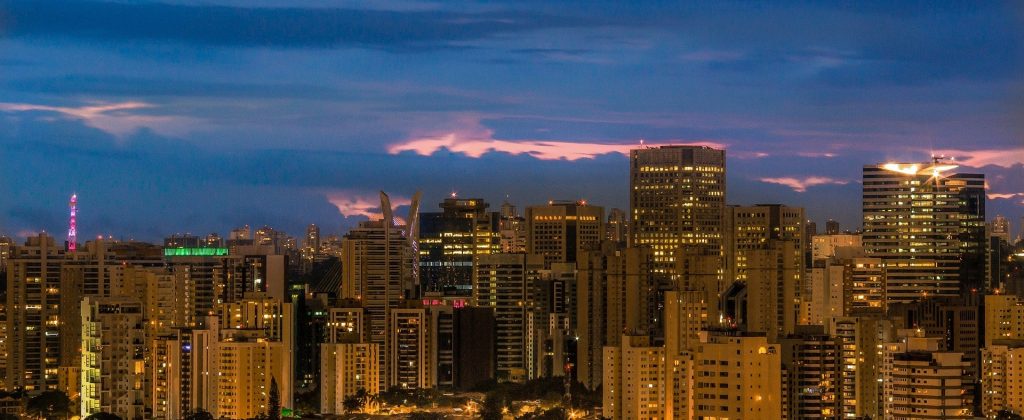
A São Paulo tour is a cultural stopover on your trip to Brazil
During your trip to São Paulo, you can also enjoy many attractions, buildings, landmarks and museums. However, the remarkable places are not necessarily close to each other and it will often be necessary to take transport to go from one to another.
We start with one of the most emblematic streets of the city, Avenida Paulista. Part of the Broadway of the tropics at 2.7 kilometers long, it is a real showcase of São Paulo and presents travelers with the epitome of commotion in a tropical megalopolis. There are many international companies that have settled there and there are many luxury shops and other shopping centers that will delight shoppers.
Among the must-see attractions on this avenue is the MASP, the largest art museum in Latin America, which offers superb collections of classical pieces as well as the exhibitions of contemporary Brazilian and foreign artists. After visiting the museum, you can cross the street to bathe in the nature of the Atlantic rainforest enclave Trianon Park, a charming area created by the French landscape gardener Paul Villon in the late nineteenth century, rich in local species.
You can then go to discover Ibirapuera Park. A remarkable ode to modernism, designed by the landscape architect Burle Marx, the green lung of São Paulo – reminiscent of Central Park in New York – houses buildings designed by the famous architect Oscar Niemeyer such as the Auditorium , the Museum of Modern Art of Sáo Paulo and the Afro Museu Brazil. You can also visit the Museum of Contemporary Art nearby or admire the monument to the glory of Pedro Alvarez Cabral, the Portuguese discoverer of Brazil.
And to finish the tour of museums, a visit to the Pinacoteca, the oldest museum in São Paulo (inaugurated in 1905) is mandatory. This museum, with over 10,000 works dating from the nineteenth and twentieth century, has the most important Brazilian artistic heritage of the world.
Another site not to be missed, is the Metropolitan Cathedral of São Paulo, also known as Catedral da Sé. Built between 1913 and 1954 on the site of the first church of São Paulo, this neogothic cathedral is one of the 5 largest in the world of this type. Restored in 2002, this imposing building stands at 92 meters high and can accommodate no less than 8,800 faithful on mass days, in a majestic setting with a 12,000-tube organ. Just in front of it is the Marco Zero monument of the city of São Paulo and the beautiful Praça da Sé square. Further on, you can visit the famous Patio do Colégio, the place of the first building of the city, which became a college then city hall and today is a museum.
Among the other beautiful buildings to discover, the Teatro Municipal de São Paulo, inspired by the Parisian Palais Garnier and completed in 1911, is one of the masterpieces of the architecture of the city. A reflection of the power and wealth of the region’s great Barons of coffee, often of Italian origin, who wished to have a place worthy of the great European capitals. It allows you to imagine the fortune of the Paulista elite at this time and is the starting point of Brazilian Modern Art that was born during the week of Modern Art in 1922. Felisberto Ranzini, who built it is also the engineer who brought to life the Mercado Municipal Paulistano with its beautiful facade and rich stained glass windows.
It brings together no less than 290 stalls that offer a rich display of drinks and various foods on the 12,600 sqm floor space. There are restaurants to appreciate the diverse flavors, this large indoor market will especially delight those of gastronomic curiosity who will not be able to pass up a Mortadella sandwich, the icon of Mercadão.
And to end on an original note, why not go strolling in the Liberdade district and discover a lesser known part of São Paulo? It is in this neighborhood that a large part of the Japanese diaspora community has settled and some streets seem imported directly from Tokyo!
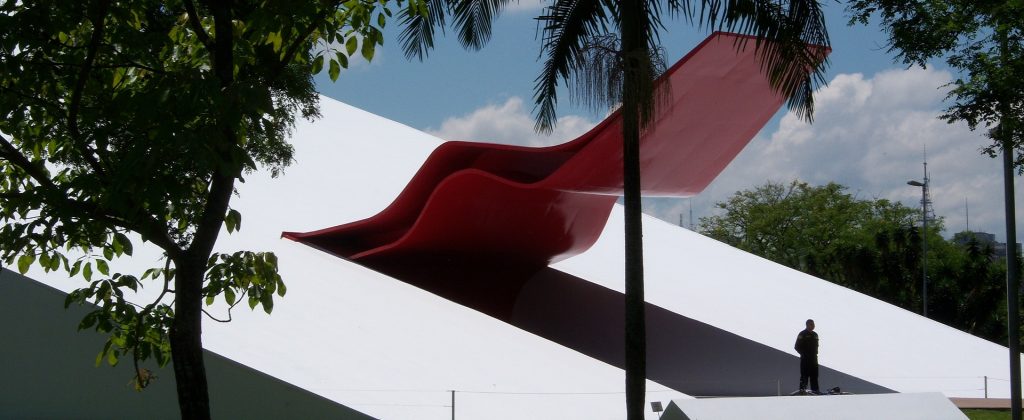
Detailed itinerary of the stay in Sao Paulo
Arrival of your flight to São Paulo.
Private transfer to your hotel in the center of the city.
If your arrival takes place in the morning or afternoon, you will go on a private visit with an English speaking guide to the center of São Paulo for about 4 hours. On the program – discovery of the most striking parts of the city!
Among them, Ibirapuera Park, the green lung of the megalopolis, its main buildings and works such as the obelisk of São Paulo and various other monuments. You will then walk down Paulista Avenue, from the local “Broadway” with prestigious brand stores and multinational headquarters.
You can also admire the remarkable buildings of the Municipal Theater of São Paulo , the Cabinet of the Municipal Prefecture, the Patio do Colégio, the building on the site of the foundation of the city, the Solar da Marquesa , the monastery of São Bento and the famous Metropolitan Cathedral facing Praça da Sé .
Night at the hotel.
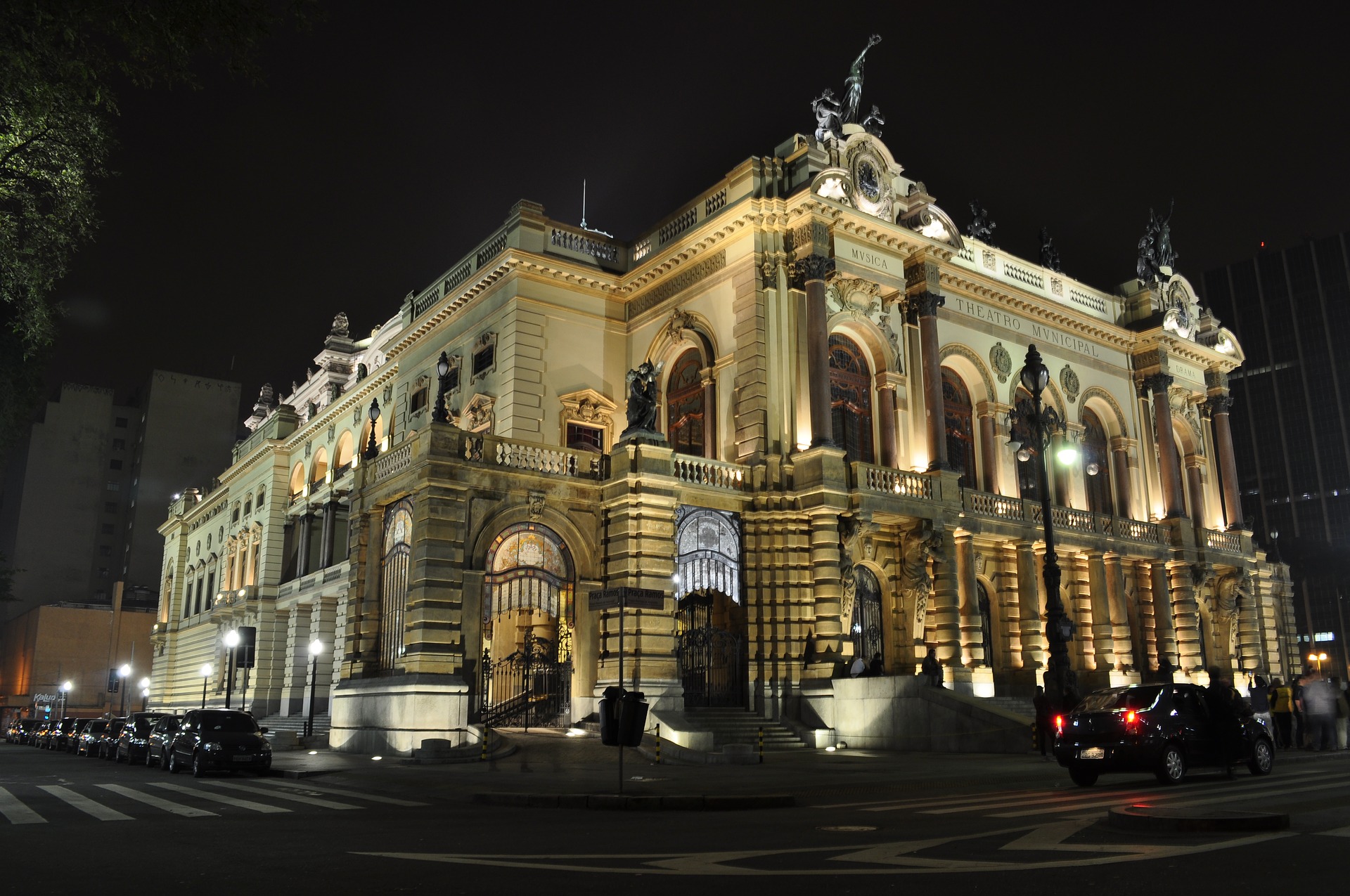
Breakfast at the hotel buffet.
Free morning. Option to do another guided tour on a particular theme (modern art tour, architecture tour, helicopter tour, visit museums – contact us)
(If you arrived in the afternoon or the evening of the first day, in the morning, you leave for the private visit of the center of São Paulo with an English-speaking guide and a vehicle.)
Check-out at noon. The reception will hold your luggage until transfer to the airport if necessary.
Private transfer to the airport of São Paulo
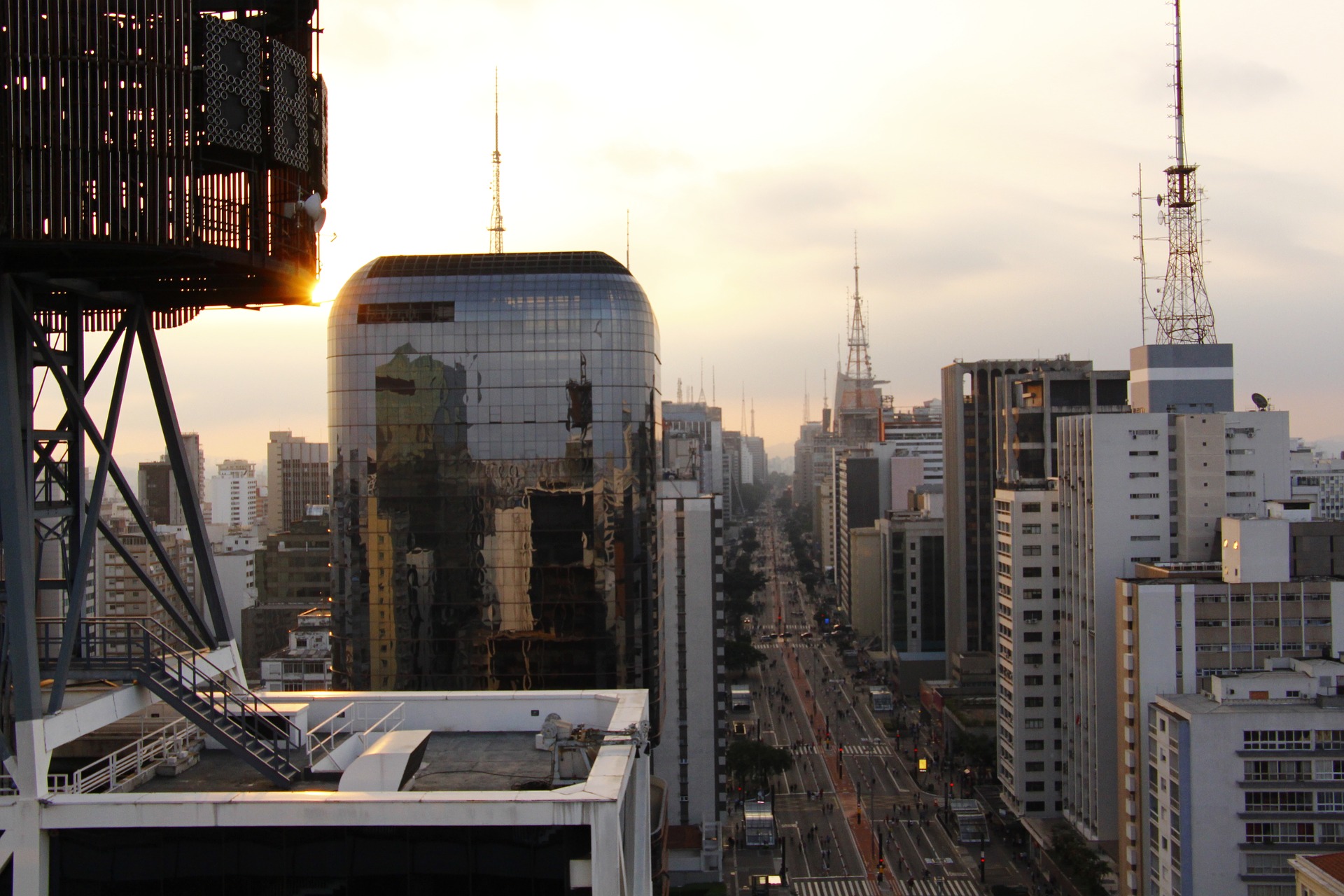
Accommodation options – São Paulo Vacation
Hotel Nobile Paulista (Standard)
The Nobile Paulista Prime has an excellent location in the heart of São Paulo near the Trianon-Masp metro, one block from Avenida Paulista, one of the largest areas of financial, cultural and leisure centers in Latin America.
Well located and modern, the hotel has all the necessary assets for a comfortable stay; rooms with contemporary decor, a pool and good value for its location near the famous MASP, ideal for a toursim based stay.
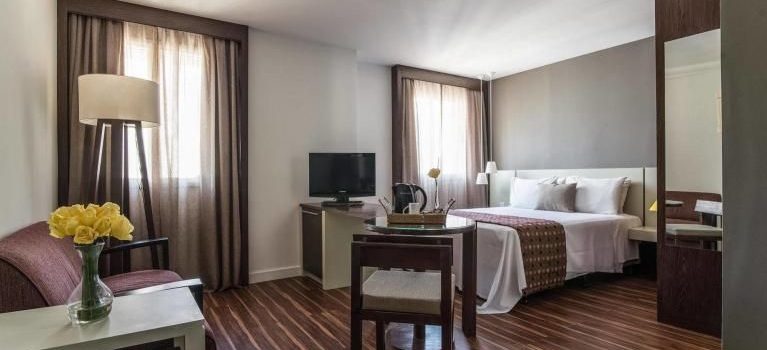
Tivoli Mofarrej Hotel (Superior)
The Tivoli Mofarrej is an upscale hotel ideal for a stay of comfort, a high – standard establishment.
Very well located in the select area of “Jardins” not far from the famous Avenida Paulista, the Tivoli Mofarrej charms with its sophisticated interior design and satisfies the most demanding travelers with its luxurious atmosphere. A beautiful pool surrounded by lush greenery on the terrace will refresh and relax and “Seen” restaurant located on the 23rd floor offers breathtaking views of the city skyline as well as superior quality cuisine prepared by Chef Olivier da Costa.
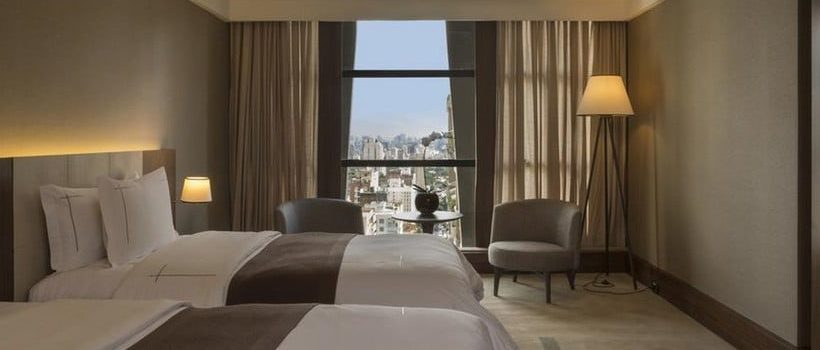
Fasano São Paulo (Luxury)
Fasano São Paulo is located in the Jardins district, 1km from Paulista Avenue and one block from Oscar Freire Street, where you will find São Paulo’s most luxurious shops. It is an exclusive establishment, which will appeal especially to lovers of exceptional accommodation where every detail counts.
The Fasano family is recognized as one of the great names in “Paulista” gastronomy, with this hotel it offers its vision of elegance and refinement, combining noble materials of the best quality and vintage design with a cozy atmosphere. The building itself has a neo retro look in homage to the 30s.
A beautiful indoor pool and spa and of course an Italian restaurant that the family is famous for will allow you to spend an unforgettable time in the Brazilian megalopolis.
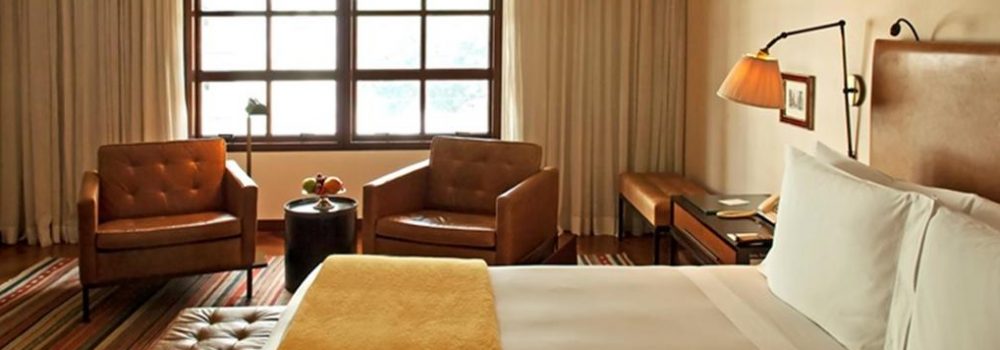
Prices for double rooms :
Catégorie supérieure : Base 2 personnes 348$ /pers – Base 4 personnes 282$ /pers
Prix basse saison de l'année en cours, donnés à titre indicatif et ne valant pas devis
Top São Paulo FAQs
When is the best time to travel to São Paulo?
The best time to visit São Paulo is from March to May or from October to November. From March to May the temperature ranges from 18 °C / 65 °F. The days are sunny and there is less rain, also there are less tourists in the city so accommodation is usually cheaper. From October to November temperature can rise as high as 25 °C / 78°F. During this season, there are more tourists and accommodation can be slightly more expensive, if you plan on going to Sáo Paulo between October and November then is is advised that you book earlier!
Events in São Paulo
Virada Cultural
(Dates: 30/05/20 – 31/05/20)
The Virada Cultural Paulistina began in 2005 and is now the biggest 24-hour festival in the world! Featuring concerts, films, art exhibitions and theatre, it draws hundreds of thousands of national and international visitors to São Paulo every year in the month of May.
Carnaval
(Dates : 21/02/20 – 26/02/20)
Although São Paulo is not the most famous carnival destination in Brazil, it is growing every year. Anhembi Sambadrome hosts the carnival in São Paulo, this is where the Samba Schools go to compete and show off their costumes, floats and choreographed dances.
Festa de São Vito
(Dates: Weekends from June – Mid July)
Festa de São Vito is the biggest Italian celebration in the country. For almost two – months, there are stalls, traditional food, parties and music celebrating St Vito who was originally from Italy. An important time of the year for the huge Italian community in São Paulo.
São Paulo Fashion Week
(2020 Dates : TBC)
São Paulo fashion week takes place twice a year in São Paulo. It now now one of the most highly regarded fashion shows in the world, in line after London, Paris, Milan and New York.
São Paulo Gay Pride Parade
(Date: 14/06/20)
São Paulo also hosts the biggest LGBT Parade in the world! In June 2020, it is estimated that 3 million people will flock to the city to enjoy the events with entire bars, clubs and neighbourhoods swinging their doors open to welcome Brazilian and International guests.
São Paulo International Film Festival (Mostra)
(2020 Dates: TBC)
In 2020, the São Paulo International film festival will be in its 44th edition. The festival screens over 300 films a year and is the gateway between international viewers and Brazilian film.
Formula 1 – Brazilian Grand Prix
Date: 15/11/20
The biggest race in Brazilian F1 takes place on Autódromo José Carlos Pace, also known as Interlagos, in the Socorro district of São Paulo. Although Brazilian President Jair Bolsonaro has claimed the 2020 will take place in Rio de Janeiro, Formula 1 authorities have denied this.
What are the top places to see in São Paulo?
São Paulo has a growing number of international visitors every year and is the largest city in the southern hemisphere. It is a modern city with an eclectic mix of cultures and ethnicities, due to the influx of migrants and workers flocking to the many multinational corporations headquartered here. The famous Avenida Paulista is the financial center of the city and is also home to large designer shops and towering glass skyscrapers. This is the center of “busy” São Paulo, where you will feel the “buzz” of the city. If you are interested in architecture, don´t miss out on “Solar da Marquesa de Santos” a heritage museum showcasing the evolution of architectural design from the 18th century.
The historical center of the city has experienced something of a revival in recent years, with more restaurants, bars and shops springing up in the area all the time. Praça da Sé is home to the biggest cathedral in São Paulo – Sé Cathedral, an alluring gothic style building with one of the largest organs on the continent. Not far from the cathedral is Pátio do Colégio. This is where it all began – the site that the Portuguese Jesuit priests built the first building in the city and founded São Paulo in 1554. The Teatro Municipal was built in 1911 and features architectural work inspired by the French Palais Garnier. It was designed by Brazilian architect Ramos de Azevedo and hosts regular opera concerts. Whilst in the area you can check two of São Paulo´s most famous skyscrapers: the Martinelli Building and Edifício Itália. The former was opened in 1929 and was the biggest skyscraper in the country at the time. Its inauguration is considered a turning point in the history of São Paulo, marking a significant step from regular city to giant metropolis. The latter offers one of the best 360° views of the city from the rooftop observation deck, and an exquisite Italian restaurant “Terraço Italia”.
The Jardins District is an upmarket and greener area of the city. The concrete skyscrapers give way to lower houses and trees line the streets and gardens. In “Jardins” you will find many restaurants and shops for the opulent residents of the area as well as upscale hotels such as the well – known Fasano. If you are in the neighborhood, it is worth checking out Xingu museum, a small but infinitely interesting Indigenous museum. Jardins is also a favourite area for foreign investors, with prices ranging as high as 40 000BRL per square meter. A short walk from Jardins will bring you back to Avenida Paulista.
Ibirapuera Park is one of the largest urban parks in Latin America, as well as the most visited park in South America with millions of visitors every year. It is located in the Vila Mariana district of São Paulo and perfect to enjoy a lazy Sunday afternoon walking through the park or sitting by the lake. Also, the Vila Mariana has a trendy nightlife and bars frequented by São Paulo´s students.
